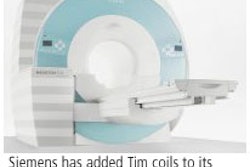Strip me naked, tar and feather me, but please, don't let anyone see my shoulder on your console!
This is the absurd end toward which some have carried patient privacy issues in the MRI suite. HIPAA was designed to protect our privacy, but the way some are choosing to implement it does so by putting our flesh-and-blood selves at greater risk.
From a patient privacy standpoint, the ideal MRI control room is walled-off and opaque. Better yet, we could do teleradiology one better and have real-time telereads, gathering technologists like air-traffic controllers in remote buildings. But to acquiesce to this HIPAA-perfect world would profoundly compromise patient care and safety.
Good medicine and patient care demand more interaction, direct observation, and real human contact. Some seem to think that these elements are a grave threat to patient privacy, particularly those requirements enacted under HIPAA.
So what, exactly, are facilities and their architects doing under the auspices of HIPAA compliance? They're building walls between the console and the magnet-room entry and, as a result, blocking any view to the magnet-room entry.
And why does this matter? Because without a view to the magnet-room approach, technologists' ability to detect potential safety hazards, such as a ferrous oxygen cylinder before they're inside the magnet room, is completely undermined.
And where is it happening? Unfortunately, it's happening regularly at new and renovated MRI facilities across the country.
Dr. Emanuel Kanal, chair of the authoring committee for the "American College of Radiology White Paper on MR Safety," and staff neuroradiologist at University of Pittsburgh Medical Center (UPMC), recently recounted precisely this experience. He reviewed prospective designs for a new MRI suite for which the designers had intended a wall to be built between the console and the magnet-room door, effectively blocking any view of the technologists to the magnet-room entry.
When pressed for an explanation, the designers said that the wall was located there because it was required by HIPAA. When Dr. Kanal challenged the design for the wall and asked to be provided with the requirement, the design was modified and the wall was removed from the design.
Undoubtedly UPMC utilizes architects and engineers with broad healthcare backgrounds and deep portfolios of experience. That these design errors are so widespread is, more than anything, a testament to HIPAA hysteria.
Without question, protecting the privacy of patients is a crucial component of effective and appropriate care, but HIPAA defines a goal and leaves the means up to us.
Sometimes we make mistakes forging a new path, and changing our facility designs to accommodate enhanced privacy protections has been no exception.
The fact is that MR control consoles should be in an access-controlled area of care. Patients coming to and from the magnet room should be, per the ACR white paper on MR safety, under the direct supervision of MR staff. Proper patient care and safety procedures require that we escort patients quickly between holding areas and the magnet room. Why then, if the patient is in a controlled area under the direct supervision of the MR staff and only fleetingly near the console, is there such a rush to impede patient safety in the interest of privacy?
Just as physicians sometimes practice defensive medicine -- prescribing tests they presume to be unnecessary to allay a patient's concern or protect themselves from the possibility of a malpractice claim -- healthcare designers are guilty of the same excess. HIPAA has noticeably changed the way we design hospital facilities, largely for the better. But many continue to overzealously apply the principles to privacy in the MRI suite and compromise care and safety in the process.
If we're going to go crazy about patient privacy, we then need to lock patients in their rooms, only transporting them blindfolded through the corridors so they don't have the opportunity to identify other patients receiving care. If, however, we're in the business of providing safe and efficient environments that promote effective delivery of care, then we need to balance concerns with patient privacy against the other components of care.
By Tobias Gilk
AuntMinnie.com contributing writer
December 6, 2005
Reprinted from www.mri-planning.com by permission of the authors. If you would like more information on any aspect of MR facility design or safety, please contact Robert Junk or Tobias Gilk at Jünk Architects.
Related Reading
Burying MRI construction mistakes: What you cannot see affects what you can, November 23, 2005
The new 'MR Safe': Language changes for the FDA, October 27, 2005
Cost of MRI mishaps makes safety investment profitable, October 14, 2005
Interim trailer leasing: The hidden cost of MRI suite renovations, September 28, 2005
A shocking story of MRI static discharge, September 21, 2005
Copyright © 2005 Jünk Architects, PC


.fFmgij6Hin.png?auto=compress%2Cformat&fit=crop&h=100&q=70&w=100)





.fFmgij6Hin.png?auto=compress%2Cformat&fit=crop&h=167&q=70&w=250)











